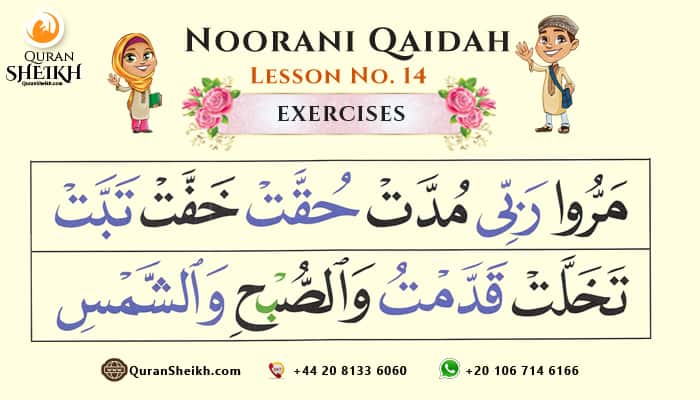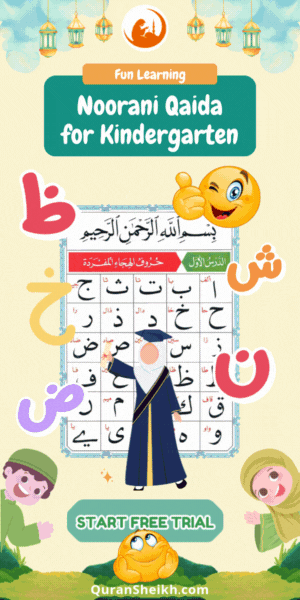Noorani Qaida Lesson 14: Master Shaddah (ــّـ) & Sukoon (ــْـ) with Guided Practice
Welcome to Noorani Qaida Lesson 14, your step to mastering Shaddah and Sukoon!
Learn Tajweed rules step-by-step to boost your fluency in Quran reading. Ideal for beginners and learners, this lesson helps you apply Shaddah and Sukoon with ease.
Noorani Qaida lesson 14 Video:
Master Shaddah & Sukoon with Noorani Qaida Lesson 14 exercises. Improve your Quranic fluency with easy Tajweed drills and examples. Start learning today!
Join thousands of Muslim Families who love learning Noorani Qaida & Quran reading from the comfort of their Homes.
Noorani Qaida page 25

Let’s start the lesson:
مَرُّوا : read it as “meem fathah ra shaddah marr, ra dammah waao ruu, marr’ruu”.
رَبِّي : read it as “ra fathah ba shaddah rabb, ba kasrah ya bee, rabb’bee”.
مُدَّتۡ : read it as “meem dammah dal shaddah mudd, dal fathah ta dat, mudd’dat”.
حُقَّتۡ : read it as “ha dammah qaf shaddah huqq, qaf fathah ta qat, huq’qqat”.
خَفَّتۡتَ : read it as “kha fathah fa shaddah khaff, fa fathah ta fat, khaff’fat”.
تَبَّتۡ : read it as “ta fathah ba shaddah tabb, ba fathah ta bat, tabb’bat”.
تَخَلَّتۡ : read it as “ta fathah ta, kha fathah lam shaddah khal, takhall, lam fathah ta laat, takhall’lat”.
قَدَّمۡتُ : read it as “qaf fathah dal shaddah qad, dal fathah meem dam, qaddam, ta dammah tu, qadd’damtu”.
وَاؐلصُّبۡحِ : read it as “waao fathah Sad shaddah waSS, Sad dammah ba Sub, waSSSub, ha kasrah hi, waSSSubhi”.
وَاؐلشَّمۡسِ : read it as “waao fathah sheen shaddah wash, sheen fatah meem sham, washam, seen kasrah si, washamsi”.
وَاؐلشَّفۡعِ : read it as “waao fathah sheen shaddah wash, sheem fathah fa shaf, washshaf, ayeen kasrah e’e, washshafe’e”.
بِالصَّبۡرِ : read it as “ba kasrah Sad shaddah biSS, Sad fathah ba Sab’b, biSS’Sab’b, ra kasrah ri, biSS’Sab’bri”.
وَاؐلصَّيۡفِ : read it as “waao fathah Saad shaddah waSS, Sad fathah ya Saie, waSS’Saie, fa kasrah fi, waSS’Saiefi”.
وَاؐلَّيۡلِ : read it as “waao fathah lam shaddah wall, lam fathah ya laie, wall’laie, lam kasrah li, wall’laieli”.
وَاؐلتِّينِ : read it as “waao fathah ta shaddah watt, ta kasrah ya tee, watt’tee, noon kasrah ni, watt’teeni”.
Learn Quran Online fast and easy with a Qualifies Arab teacher, Get 30% OFF join now.
وَاۡلزَّيۡتُونِ : read it as “waao fathah za shaddah wazz, za fathah ya zaie, wazzzaie, ta dammah waao tuu, wazzaietuu, noon kasrah ni,wazzzaietuuni”.
سِجِّيلٍ : read it as “seen kasrah jeem shaddah sijj, jeem kasrah ya jee, sijj’jee, lam kasratain lin, sijj’jeelin”.
سِجِّينٌ : read it as “seen kasrah jeem shaddah sijj, jeem kasrah ya jee, sijj’jee, noon dammatain nun, sijj’jeenun”.
مُنۡفَكِّينَ : read it as “meem dammah noon mun, fa fathah kaf shaddah fakk, munfakk, kaf kasrah ya kee, munfakk’kee, noon fathah na, munfakk’keena”.
فَإِنَّ اؐلۡجَنَّةَ : read it as “fathah fa, hamzah kasrah noon shaddah inn, fainn, noon fathah lam nal, fainnal, jeem fathah noon shaddah jann, fainn’naljann, noon fathah na, fainn’naljann’na, ta fathah ta, fainn’naljann’nata”.
لِحُبِّ اؐلۡخَيۡرِ : read it as “lam kasrah li, ha dammah ba shaddah hubb, lihubb, ba kasrah lam bil, lihubb’bil, kha fathah ya khaie, lihubb’bilkhaie, ra kasrah ri, lihubb’bilkhaieri”.
إِذَااؐلسَّمَآءُ اؐنۡشَقَّتۡ : read it as “hamzah kasrah e, zal fathha seen shaddah zass, ezass, seen fathah sa, ezass’sa, meem fathah alif maa, ezass’samaaaa, hamzah dammah noon unn, ezass’samaaaaunn, sheen fathha qaaf shaddah saqq, ezass’samaaaaunnshaqq, taf fathah ta qat, ezass’samaaaaunnshaqq’qt”.
مَااؐلطَّارِقُ اؐلنَّجۡمُ اؐلثَّاقِبُ : read it as “meem fathah Ta shaddah maTT, Ta fathah alif Taa, maTT’Taa, ra kasrah ri, maTT’Taari, qaf dammah noon shaddah qunn, maTT’Taariqunn, noon fathah jeem naj’j, maTT’Taariqunn’naj’j, meem dammah sa shaddah muss, maTT’Taariqunn’naj’jmuss, sa fathah alif saa, maTT’Taariqunn’naj’jmuss’saa, qaf kasrah qi, maTT’Taariqunn’naj’jmuss’saaqi, ba dammah bu, maTT’Taariqunn’naj’jmuss’saaqibu”.
مِنۡ شَرِّاؐلۡوَسۡوَاسِ اؐلۡخَنَّاسِ : read it as “meem kasrah noon min, sheen fathah ra shaddah sharr, minsharr, ra kasrah lam ril, minsharr’ril, waao fathah seen was, minsharr’rilwas, waao fathah alif waa, minsharr’rilwaswaa, seen kasrah lam sil, minsharr’rilwaswaasil, kha fathah noon shaddah khann, minsharr’rilwaswaasilkhann, noon fathah alif naa, minsharr’rilwaswaasilkhann’naa, seen kasrah si, minsharr’rilwaswaasilkhann’naasi”.
Noorani Qaida lesson 14
Noorani Qaida PDF:
Download Noorani Qaida Book as a PDF file, please click on download icon.
Noorani Qaida Online Course:
Quran Sheikh Institute provide you Noorani Qaida course Register now and get 25% OFF.
Start noorani qaida lessons and know how to read Arabic Alphabet up to read Quran with Tajweed insha Allah well.
Learn Quran for Kids & Adults – From Beginner to Fluent
Free Trial Lesson – Sign Up Today

What is the main focus of Noorani Qaida Lesson 14 exercises?
What are the separately recited letters in Noorani Qaida Lesson 3?
The main focus is to practice reading words and phrases combining Shaddah and Sukoon fluently, progressing from letter-by-letter pronunciation (Hijja) to reading without Hijja.
What does “reading without Hijja” mean in Lesson 14?
“Reading without Hijja” means reading entire words directly, without spelling out each letter and its vowel sound. For example, reading “مَرُّوا” directly instead of saying “meem fathah ra shaddah marr, ra dammah waao ruu, marr’ruu.”
How should I pronounce Hamzah Wasl (اؐ) in the examples in Lesson 14?
✔️ Beginning of a phrase: Follow the standard Hamzah Wasl rule (look at the third letter for vowel).
✔️ Middle of a phrase: Skip the Hamzah Wasl; don’t pronounce it.
Where should Ghunnah be applied in Lesson 14 exercises?
Apply Ghunnah (a nasal sound) on noon (نّ) and meem (مّ) letters that have Shaddah. Hold the sound for the appropriate duration.
Give examples of words covered in Noorani Qaida Lesson 14.
Examples include: مَرُّوا, رَبِّي, وَاؐلصُّبۡحِ , سِجِّيلٍ, مُنۡفَكِّينَ, and phrases like مِنۡ شَرِّاؐلۡوَسۡوَاسِ اؐلۡخَنَّاسِ.
What is the most effective way to practice this lesson?
Practice each example repeatedly without Hijja, focusing on smooth transitions between letters and applying the rules of Shaddah, Sukoon, Hamzah Wasl, and Ghunnah accurately.
Why is understanding previous lessons important for Lesson 14?
Lesson 14 combines all the rules learned in earlier lessons. If you struggle, review the lessons on Sukoon, Shaddah, and Hamzah Wasl before continuing.
Noorani Qaida Lesson 14 builds fluency by combining Shaddah (doubled letters) and Sukoon (resting sound) in the same word. Mastering this lesson unlocks more complex Quranic reading.
How to read words with both Shaddah and Sukoon?
First, apply the Shaddah: pronounce the letter as doubled (Sukoon + vowel). Then, pronounce any Sukoon letters with a brief, resting sound. Example: مُدَّتۡ (Muddat) = “Mudd” then “dat” combining the rules you learnt.
What is Hamzah Wasl and how do I use it when reading these words?
Remember to pronounce the Hamzah Wasl with a vowel depending on the third letter, or if Hamzah Wasl appears in the middle of a word, then you skip it.
How do I decide when to apply Ghunnah in the Lesson 14 exercises?
When you see a Noon (نّ) or Meem (مّ) with a Shaddah, apply Ghunnah. You will need to apply a nasal sound and hold for 2 counts. Example: اَلْجَنَّةَ – You must apply Ghunnah on the “Nunn”.
How do I remember to read “without Hijja”?
Reading without Hijja helps you avoid reading each letter. Read the words naturally, following the correct Tajweed rule that you’ve learned so far.
What is the best way to practice this lesson?
Take each exercise and read it over and over until you get it correct. Try not to sound out the letters, but instead read the words in one go. If you are still stuck, then return to some previous lessons and review before trying again.
Explore Previous Lesson:
Shaddah (Tashdeed) Exercises
Noorani Qaida Lesson 13
Master the Next Step:
Double Shaddah (Tashdeed) Exercises





